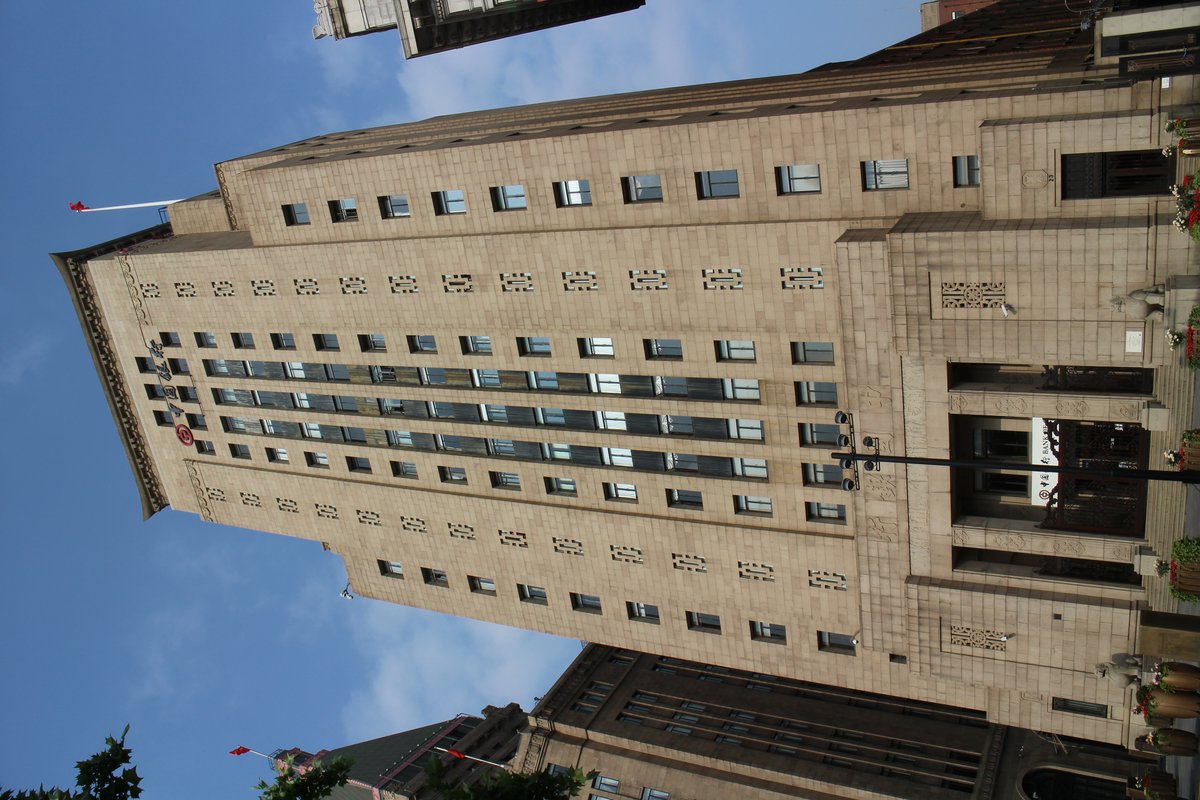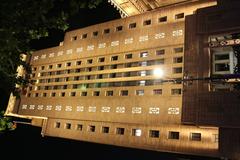
Bank of China Building, Shanghai: Visiting Hours, Tickets, and Historical Significance
Date: 15/06/2025
Introduction
The Bank of China Building, located at No. 23 on Shanghai’s iconic Bund waterfront, is a landmark that encapsulates the city’s rich financial heritage and architectural innovation. Completed in 1937, it stands as a striking fusion of Western Art Deco and traditional Chinese motifs, symbolizing Shanghai’s emergence as a cosmopolitan financial hub and the assertion of Chinese modernity during a period dominated by foreign influence. Designed primarily by pioneering Chinese architect Lu Qianshou (Luke Him Sau) with British and European collaborators, the building masterfully utilizes its challenging, narrow site at the intersection of the Bund and Nanjing Road. Today, it remains an essential stop for history buffs, architectural enthusiasts, and travelers exploring Shanghai’s celebrated waterfront (Trippest, Shine.cn, Lonely Planet, Asia Odyssey Travel).
Contents
- Historical Background
- Architectural Significance
- East-Meets-West Design
- Site Constraints & Urban Integration
- Distinctive Features
- Visitor Information
- Location & Access
- Visiting Hours & Tickets
- Accessibility
- Practical Travel Tips
- Nearby Attractions
- Frequently Asked Questions (FAQ)
- Conclusion
- Sources
Historical Background
The site originally housed the German Club in the early 1900s before being seized by the Chinese government during World War I and later acquired by the Bank of China. The Shanghai branch of the Bank of China was established in 1912, and by 1928, the bank had moved its head office from Beijing to Shanghai. Determined to compete with prominent foreign banks and project national pride, the Bank of China commissioned a new headquarters on the Bund (Lonely Planet).
The building was completed in 1937. Its design represents the era’s economic ambition and resilience, as construction faced significant delays due to the Second Sino-Japanese War. The Bank of China Building quickly became a symbol of Chinese financial independence and innovation in a city then known as the “Wall Street of the East” (Discover China Guide).
Architectural Significance
East-Meets-West Design
The Bank of China Building is unique among the Bund’s edifices as the only major one designed by Chinese architects. Lead architect Lu Qianshou, with guidance from the British firm Palmer & Turner, created a harmonious blend of Western Art Deco and traditional Chinese elements. The building’s massing, strong horizontal lines, and granite façade showcase Art Deco influence, while Chinese motifs—like lattice windows and stylized cloud patterns—convey national identity (Shine.cn).
Site Constraints & Urban Integration
Constructed on a narrow, irregular plot at the intersection of the Bund and Nanjing Road, the building’s design overcame significant spatial challenges. The crescent-shaped façade follows the curve of the adjoining roads, enhancing visibility and prominence. This creative approach maximized interior space and contributed to its distinctive silhouette among neighboring rectilinear buildings (Shine.cn).
Distinctive Features
- Granite and Brick Facade: The lower floors employ granite for strength and solidity, while the upper floors—originally intended as bank staff apartments—feature brickwork.
- Art Deco Lions: Iconic lion statues flank the main entrance, symbolizing strength and prosperity.
- Chinese Decorative Details: Motifs such as the “Eight Immortals Crossing the Sea” and the character for “longevity” appear in ironwork and lobby decorations.
- Spatial Efficiency: Despite a small footprint, the building originally housed banking halls on the lower floors and apartments on the upper levels, a pioneering example of mixed-use design for the era (Trippest).
Visitor Information
Location & Access
- Address: No. 23 East Zhongshan No. 1 Road (中山东一路23号), Bund, Shanghai
- Metro: East Nanjing Road Station (Lines 2 and 10), approximately a 10-minute walk
- Bus: Multiple routes along Zhongshan Road
- Taxi/Ride-hailing: Available citywide
Visiting Hours & Tickets
- Exterior Viewing: The Bund promenade is open 24/7 and free to explore (China Discovery).
- Building Lobby: Generally open to the public during standard bank hours (9:30 am – 6:00 pm, Monday to Friday). Check the official Bank of China Shanghai branch website for current hours.
- Tickets: No tickets are required to view the exterior or lobby. The upper floors and interior tours are not open to the public.
Accessibility
- The Bund promenade and the Bank of China Building’s lobby are wheelchair accessible.
- Elevators are available in the building for banking customers, but access to upper floors is restricted.
- Public transportation stations nearby have accessibility features.
Practical Travel Tips
- Best Time to Visit: Spring (March–May) and autumn (September–November) offer the most pleasant weather.
- Photography: Exterior and lobby photography is usually allowed; check posted signs for restrictions inside.
- Safety: Shanghai is generally safe, but practice common-sense security in crowded areas.
- Payments: Mobile payment apps (Alipay, WeChat Pay) are widely used. Carry cash for small purchases.
Nearby Attractions
- Peace Hotel: Historic Art Deco hotel just north of the Bank of China Building.
- Customs House: Iconic for its clock tower, another Bund landmark.
- Nanjing Road: Shanghai’s famed shopping street is a short walk away.
- Huangpu River Cruises: Scenic boat tours offer stunning views of the Bund and Pudong skyline (China Highlights).
Frequently Asked Questions (FAQ)
Q: Can I enter the Bank of China Building?
A: The building’s exterior and lobby can be visited during banking hours. The upper floors are not open to the public.
Q: Is there an admission fee?
A: No, the building and promenade are free to visit.
Q: Are guided tours available?
A: Public guided tours are not available inside the building, but many Bund walking tours include the Bank of China Building as a point of interest.
Q: Is the site wheelchair accessible?
A: Yes, the promenade and lobby are accessible.
Q: When is the best time for photography?
A: Sunset and nighttime, when the building and skyline are illuminated.
Conclusion
The Bank of China Building stands as a symbol of Shanghai’s dynamic past, blending Chinese tradition with Art Deco modernism. As the only major Bund building designed by a Chinese architect, it represents a proud assertion of national identity amid the city’s cosmopolitan landscape. While interior access is limited, its magnificent façade, prime location, and historical significance make it a must-see for visitors exploring Shanghai’s vibrant waterfront. Pair your visit with nearby attractions for a richer experience, and consult official sources and travel apps for the latest information.
Sources and Further Information
- Bank of China Official Website
- Shine.cn: Architect of Shanghai’s Iconic Bank of China
- Lonely Planet: Bank of China Building
- Asia Odyssey Travel: The Bund






















































































